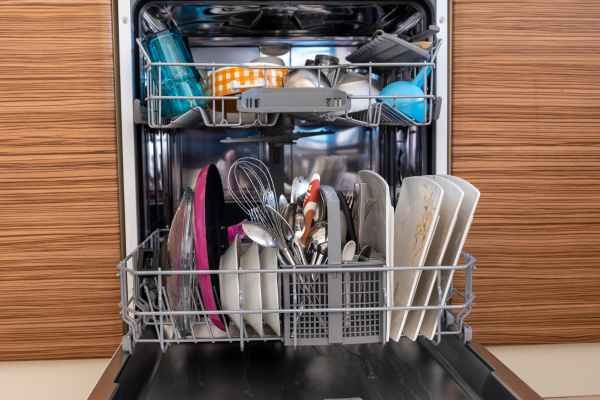If you’ve noticed the clean light blinking on your KitchenAid dishwasher, you’re not alone. While this small light might seem insignificant, it actually serves as a key communication tool between your appliance and you. Understanding what it’s trying to tell you can save you both time and frustration. Whether it’s a routine notification or a warning sign of a deeper issue, addressing the blinking clean promptly can help keep your dishwasher running efficiently.
Understanding the “Clean Light” Indicator on Your KitchenAid Dishwasher
The “Clean” light on a KitchenAid dishwasher typically lights up after a successful cycle, letting you know your dishes are clean and ready to be unloaded. However, when this light starts blinking instead of remaining steady, it signals that something didn’t go as expected during the wash cycle. It might indicate that the water didn’t heat up to the necessary temperature, that a part isn’t functioning properly, or that a cycle was interrupted. Essentially, the blinking clean is a built-in error message—an early warning system that your dishwasher needs attention before resuming normal operation.
Common Reasons Behind the Clean Light Blinking on KitchenAid Dishwasher
Several factors can trigger the clean light to blink. One of the most common causes is a failure to reach the correct water temperature during a cycle, often due to a faulty heating element. Another frequent reason is an interrupted cycle—such as when the door is opened mid-wash or a power outage occurs. Issues with sensors, clogged filters, or drainage problems can also cause the clean to blink. Sometimes, it’s simply a glitch in the control board that can be resolved with a reset. Identifying the root cause involves observing the dishwasher’s recent behavior and checking for additional signs like standing water, error codes, or inconsistent washing performance.
How the Dishwasher’s Self-Diagnostic System Works
KitchenAid dishwashers are equipped with a smart self-diagnostic system that constantly monitors key components during every wash cycle. This system checks for issues like temperature irregularities, improper drainage, or electrical malfunctions. If anything falls outside of the programmed norms, the system flags the error and communicates it through the control panel—often via blinking lights like the clean. This intelligent feature helps users quickly identify when something is wrong without needing to open the unit or disassemble components. In some models, entering diagnostic mode will even trigger specific light patterns that correspond to detailed error codes, helping technicians and homeowners pinpoint problems faster.
When a Clean Light Blink Is Just a Simple Notification
Not every blinking clean is a cause for alarm. In many cases, it can be the result of something as harmless as pausing or interrupting a wash cycle. For example, opening the dishwasher door mid-cycle or accidentally pressing a button might confuse the system and result in the blinking light. Similarly, a momentary power loss can cause the machine to stop mid-process and flash the clean as a way to indicate that it didn’t finish the cycle properly. In these cases, a simple reset is usually enough to get things back to normal. Think of it as your dishwasher’s way of asking for a restart after being cut off mid-sentence.
Is It a Malfunction or a Maintenance Alert?
Distinguishing between a system malfunction and a routine maintenance alert is essential when dealing with a blinking clean light. A malfunction typically involves a faulty component—like a broken heating element, a malfunctioning thermostat, or a clogged drain pump—that prevents the dishwasher from operating correctly. On the other hand, a maintenance alert might be triggered by dirty filters, a buildup of food debris, or even sensor feedback that detects unusual but non-critical conditions. The key to telling them apart lies in how your dishwasher performs. If dishes come out dirty, cycles don’t complete, or water remains at the bottom of the tub, it’s likely a malfunction. If everything seems to work except the blinking light, a reset and routine cleaning might be all you need. Clean Blinking On Kitchenaid Dishwasher.
Step-by-Step Guide to Reset a KitchenAid Dishwasher
When the clean light keeps blinking, the first line of defense is to perform a reset. This clears any temporary errors and gives your dishwasher a fresh start.
Manual Reset Method

Start with the simplest approach: turn the dishwasher off and on again. Locate the dishwasher’s power button and press it to shut the unit down. Alternatively, unplug the appliance or switch off the circuit breaker. Wait about 5–10 minutes to allow the system to discharge completely. Afterward, restore power and run a rinse cycle to see if the blinking light issue is resolved. This manual reset often clears glitches caused by power interruptions or accidental button presses.
Heated Dry Reset Method

Many KitchenAid models support a more advanced reset using the control panel. With the door closed, press the following button sequence: “Heated Dry” → “Normal” → “Heated Dry” → “Normal.” Press each button quickly, within five seconds. This initiates a short diagnostic cycle. You’ll know it worked when all the lights on the control panel flash briefly. Once the diagnostic cycle finishes, the dishwasher should return to normal operation, and the clean will stop blinking.
Control Panel Button Sequence

If your model lacks a Heated Dry button or behaves differently, try this alternative: press any three buttons (e.g., Hi Temp → Heated Dry → Start) in a sequence twice. When done correctly, all LEDs on the panel will illuminate, indicating diagnostic mode. Let the dishwasher complete the internal check. This can clear stored fault codes and restore normal function.
Quick Fixes to Try Before You Call a Technician
If the blinking clean light persists after a reset, there are a few easy fixes you can try. First, make sure the dishwasher door is closing and latching properly. An unlatched door can interrupt the cycle and trigger the clean warning. Next, inspect the bottom of the dishwasher tub for standing water, which could point to a drainage issue. Clean the filters and spray arms to ensure water is flowing freely throughout the machine. Also, run hot water from your sink faucet for a few minutes before starting the dishwasher—this helps the appliance reach the necessary temperature faster. These simple actions may resolve the issue without the need for expert assistance.
How to Check the Heating Element and Its Role in the Clean Light Error
The heating element plays a crucial role in ensuring dishes are sanitized and properly dried. If the water doesn’t heat to at least 120°F (49°C), the dishwasher will pause or stop the cycle and flash the clean light. To inspect the heating element, locate it at the bottom of the dishwasher tub—it looks like a curved metal rod. Check for visible damage, such as cracks or burn spots. You can also test the element with a multimeter for continuity. If it shows no electrical flow, the part is defective and should be replaced. A malfunctioning heating element is one of the most common causes of a blinking clean and requires timely attention to restore proper performance.
The Connection Between Drainage Issues and a Blinking Clean Light
Drainage problems are another leading cause of the clean light blinking on a KitchenAid dishwasher. If the water doesn’t fully drain at the end of the cycle, the system registers it as an incomplete cycle and triggers the blinking light. Start by checking the dishwasher’s drain hose, located under the sink. Make sure it’s not kinked, clogged, or improperly installed. Next, inspect the garbage disposal or air gap for obstructions, especially if the dishwasher shares a drain with your sink. Finally, listen to the drain pump during a cycle. If it’s unusually quiet or makes a grinding noise, it may be failing. Clearing blockages or replacing the pump, if necessary, can often resolve the issue and stop the clean from flashing.
Inspecting and Cleaning the Filters and Spray Arms
One of the simplest yet most overlooked causes of dishwasher malfunction is clogged filters or blocked spray arms. These components are essential for proper water circulation and debris removal. Over time, food particles, grease, and soap scum accumulate, reducing efficiency and triggering faults—like the blinking clean. To clean the filters, remove the bottom rack and locate the circular mesh filter and cylindrical coarse filter beneath it. Rinse both under warm water and use a soft brush to remove grime. Next, inspect the spray arms—remove them if possible and clean out any debris stuck in the holes using a toothpick or brush. Once everything is clear and reassembled, your dishwasher should function more effectively, reducing the chance of error signals during a wash cycle.
Power Supply and Wiring Problems That Could Trigger the Blinking Light
Electrical inconsistencies are another common culprit behind a blinking clean light. A brief power interruption, loose wiring, or even a surge can confuse the dishwasher’s control board, leaving it in an error state. Begin by checking the circuit breaker that supplies power to the dishwasher. Reset it if necessary. Next, inspect the power cable and junction box (usually located behind the kickplate at the bottom front of the dishwasher). Look for loose connections, frayed wires, or burn marks. If your dishwasher is hardwired and you’re unsure how to inspect safely, it’s wise to have an electrician look at it. Stable power ensures the control panel receives consistent signals, which is vital for a smooth, uninterrupted wash cycle.
Troubleshooting the Thermostat and Temperature Sensor
A malfunctioning thermostat or temperature sensor can cause water to stay too cold, preventing proper cleaning and triggering the clean light to blink. These components help regulate and report the water temperature inside the dishwasher. If the system detects that the water didn’t heat up as expected, it assumes the cleaning process failed. To diagnose, access the thermostat (often located behind the lower access panel). Use a multimeter to test for continuity. If it fails, it needs to be replaced. Similarly, a faulty thermistor (temperature sensor) might provide inaccurate readings, confusing the control board. Replacing these parts is usually inexpensive and can resolve persistent blinking issues related to heat cycles.
Eco-Friendly Maintenance Tips to Prevent Future Blinking Light Issues
Maintaining your KitchenAid dishwasher doesn’t have to be time-consuming or expensive. A few sustainable habits can extend the life of your appliance and prevent annoying issues like the blinking clean. Use vinegar as a natural cleaner—run an empty cycle with a cup of white vinegar on the top rack to remove mineral buildup. Sprinkle baking soda on the bottom of the dishwasher before a short cycle to freshen odors. Avoid harsh detergents that leave residue, and instead opt for eco-certified products. Rinse heavy food particles off dishes before loading to prevent clogs in filters and spray arms. These simple, eco-conscious practices promote smoother cycles and reduce the chances of errors and breakdowns.
When to Repair and When to Replace Your Dishwasher
If the clean continues blinking despite all your efforts, it might be time to ask a bigger question: should you repair or replace the unit? Consider repair if the dishwasher is less than 8–10 years old, and the issue involves replaceable parts like heating elements, sensors, or pumps. These repairs are generally cost-effective and can restore full function. However, if the control board is failing, multiple components need replacing, or you’ve had frequent issues recently, it might be more economical to invest in a new unit. Modern dishwashers are more energy-efficient and come with advanced diagnostics that can prevent similar headaches down the road.
How to Prevent Clean Light Errors with Simple Weekly Maintenance
Prevention is always better than cure, especially with home appliances. A simple weekly maintenance routine can go a long way in keeping your dishwasher error-free. Wipe down the interior walls and door gasket with a damp cloth to prevent mold and buildup. Clean the filter and check for debris at the bottom of the tub. Run the dishwasher empty with hot water and vinegar once a week. Avoid overloading or blocking spray arms, and always ensure the detergent dispenser opens freely. These quick habits can dramatically reduce the risk of the clean blinking and extend your appliance’s performance lifespan.
Final Thoughts
A blinking clean light on your KitchenAid dishwasher is more than just an inconvenience—it’s a helpful alert that your machine needs attention. Whether the cause is a clogged filter, faulty thermostat, or interrupted cycle, most problems have straightforward solutions. With the right knowledge and a little maintenance, you can resolve the issue yourself, saving money and avoiding unnecessary downtime. Keep your dishwasher in top shape by listening to what it’s trying to tell you—and giving it the care it deserves. A clean kitchen starts with a clean, properly working dishwasher.
